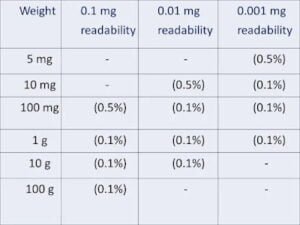Analytical Balance Performance Verification
Analytical Balance Performance Verification
Objective
The purpose of this SOP is to detail the procedure for verifying the performance of Analytical balances. This SOP is based on the USP chapter <41> “Weight and Balances”
Scope
The procedure applies to all Balances at QC /Analytical Laboratory of xxx (where xxx is the company name)
Responsibility
Research Scientist/Chemists/Analyst
HOD
To ensure the implementation of this SOP in the Analytical development laboratory or Quality control Laboratory (as applicable).
Frequency
Once in six months ± five days
Performance Verification procedure
- Before going to performance verification check whether the air bubble is in the correct position or not. If not, adjust air bubbles using screws.
- Check the internal calibration /drift (daily test)
- Perform the daily verification
- Quarterly Testing
- The Analytical balances must be checked with a certified calibrated set of weights at the frequency of every 3 months (quarterly) or in case of relocation, power failure or balance repair.
Procedure
- The following weights should be used based on the type of balance with acceptance criteria in the bracket
- Analytical balance (readability
Table-1
Perform six weighing of each of the calibrated weights. Remove the weight and re-zero the balance after each weighing. see the weighing point on the weighing pan👇
Calculate the mean and standard deviation (SD) of the weighings. The Random error (RE) is defined as the three times standard deviation👇 RE = (3 x SD)The systematic error (E) is defined as the absolute difference between the mean of the weight and weight calibrated mass👇SE = (AVG – WCM)
Note: WCM value is obtained from the certified calibration laboratory.
Calculation method and acceptance criteria
Calculate the sum of the error according to the following formula👇:
∑=(RE+SE)WCM×100
The ∑ acceptance criteria (in %) for each taste are mentioned in Table -1 (procedure section)
Uncertainty
Perform the replicate weighing of the weights mentioned below. Remove the weight and re-zero the balance after each weighing. Calculate uncertainty by following formulae👇:
Uncertainty=Standard deviation×3 Certified weight value
Acceptance criteria = NMT 0.001
Check the uncertainty by using the weights as per balance readability.
- For Analytical Balances (0.1mg readability) check of the weights of 100mg, 1gm, 10gm, and 100gm
- For Semi-micro Balances (0.01mg readability) check the weights of 10mg, 100mg, 1gm, and 10gm
- For Micro Balances (0.001mg readability) check the weights of 5mg, 10mg, 100mg, and1gm
If fail the test, the Balance will be labelled ” Out of order” and a service engineer should be summoned.
Documentation
The results of quarterly testing will be documented in the QA form.
Calibration of weights
The sets of weights used for calibration should be calibrated by a certified Laboratory periodically or as per the re-calibration due date given by the external agency performing the calibration.
You may also want to check out other articles on my blog, such as:
- How to calibrate KF?
- How to calibrate GC?
- How to calibrate a UV spectrophotometer?
- How to calibrate FTIR?
- How to perform calibration of pH meter?
- How to calibrate KF apparatus?
- How to calibrate UPLC?
- How to calibrate HPLC?
Abbreviations:
SOP: Standard operating procedure
HOD: Head of department
RE: Random error
SE: Systematic error
g or gm: Gram
NMT: Not more than
AVE: Average of the weight or mean of the weight
WCM: weight calibrated mass
References
- USP; General Chapter <41> “Weights and Balances”.





 Previous Post
Previous Post